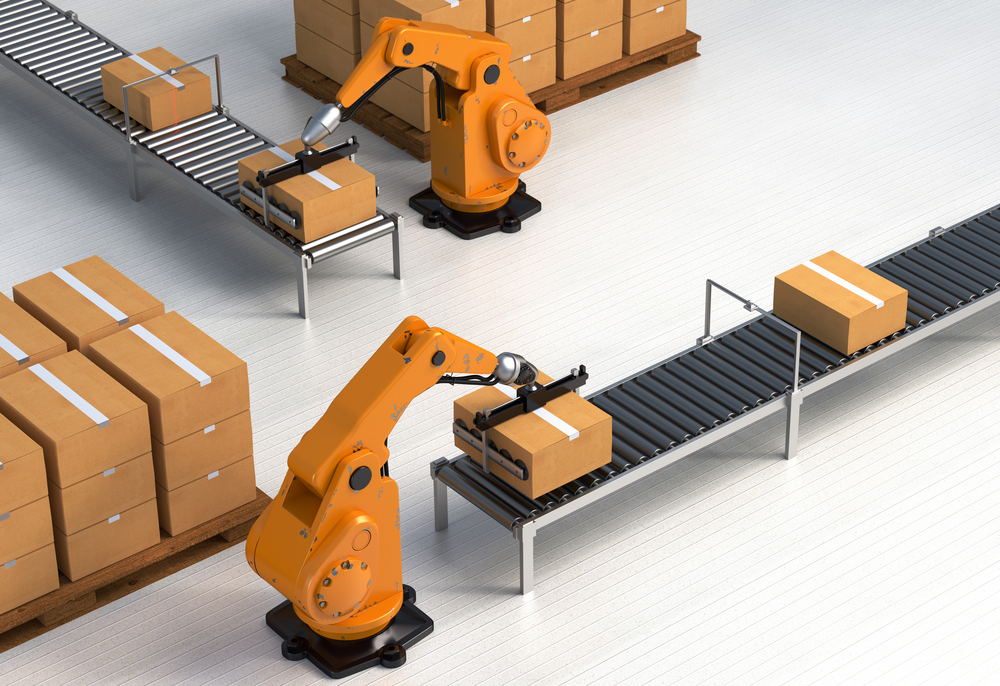ARTICLE UPDATED ON JULY 29, 2023
Technology plays an increasingly vital role throughout the supply chain. With the increased use of automated systems and artificial intelligence (AI), manufacturers and retailers are implementing more efficient processes as they navigate ongoing supply chain challenges. For many, fully automized robotic palletizing systems have taken the place of human labor when it comes to the onerous and repetitive task of stacking products on pallets in many production facilities. In some cases, the total throughput of the facility may not be enough to justify the space and expense of automatic palletizing systems – leaving many manufacturers and distribution centers still palletizing their products manually, a time consuming and costly task. As the industry continues to make strides, the benefits of using an automated robotic palletizing system may make it a practical option for facilities of various sizes.
What Is Automatic Palletizing?
Automated palletizing involves the use of machinery to sort, line up, and turn products as they make their way down a conveyor belt. They are then deposited on a pallet layer by layer and wrapped in plastic via a process that rotates the entire pallet. Lastly, a conveyor belt may carry the finished pallet to the loading dock and deposit it in truck trailers.
These systems can sort and palletize massive numbers of cartons; however, they do have their disadvantages. To start, these systems take up a great deal of space, with hundreds of feet of conveyor belts required to move and adjust cartons. Secondly, this sort of automatic palletizing isn’t very flexible and product changes and packaging redesigns may require troubleshooting (and, in some cases, an overhaul of the automated system, to ensure that products are palletized reliably). The addition of robotic technology can help address many of these challenges.
Automatic robot palletizing involves a system that uses robotic arms to pick products, identify where they belong, and place them on the correct pallet. The products to be palletized are brought to the robots on a conveyor belt. Via a programmable controller, these palletizing robots can work very independently, and depending on the specific configuration, can process more than one product simultaneously. This addition of robotic arms, coupled with sensors and analytical algorithms, allows a great deal of flexibility in the system, making it possible to efficiently stock mixed-case pallets that carry a variety of different products. These systems also allow for flexibility throughout the supply chain. For example, with automatic robot palletizing, a redesign of products or packaging necessitates merely a reprogramming of the robotic arms rather than a fundamental rebuild of the entire core system. Automatic robot palletizing systems offer many benefits and are often an effective way to mitigate key efficiency challenges in the supply chain.
Further Benefits of Automatic Robotic Palletizing Systems
There is a growing movement to fundamentally change the dominant business model from a linear “make, purchase, and discard” model to a circular business model in which packaging and products are recycled or reused. In fact, the World Economic Forum states that if enterprises have not made the switch to the circular business model by 2030, they will no longer remain competitive.
The sustainable packaging being developed for the circular model is lightweight and often made of biodegradable or reusable materials. For this reason, it may not always be durable enough for traditional automated palletizers. The lighter touch of an automatic robot palletizing system is often an ideal solution. And since new packaging designs will likely go through several iterations, perhaps the greatest benefit of robotic palletizing is its flexibility. And there are other advantages to consider:
- Smaller Scale: Robotic palletizers take up far less space than more conventional conveyor-based systems. This allows them to be used in small-scale facilities where space for palletizing is at a premium. Retrofitting a facility that had been using automated palletizing with robotic palletizers may also open space for other uses.
- Modular Design: A automatic robot palletizer is much more modular than traditional forms of automated palletizing. Largely self-contained, robotic arms fit in smaller areas and multiple robotic arms can work simultaneously on the same product line or on different product lines. They can also switch between programming for different products and pallet plans easily, allowing for flexibility as demanded.
- Reduced Operating Costs: Robotic palletizers will deliver positive results while lowering operational costs. The efficiency of the robots used in these systems allows for reduced labor costs, increased throughput, and low numbers of product waste.
- Seamless Integration: Integrating automatic robot palletizers into existing spaces and into existing production flow is relatively easy, as they are self-contained units. Robotic palletizers and Autonomous Guided Vehicles (AGVs) can service newly established smaller-scale production lines alongside an existing large-scale automated palletizer, allowing for easy testing of new products without disruption to existing operations. Companies can begin piloting and testing new products, packaging, and supply chain models while continuing existing product lines and servicing existing customers.
- Improves Warehouse Safety: Automatic robot palletizing systems eliminate many workplace hazards, since warehouse employees no longer need to worry about most safety threats associated with manual palletizing tasks. Such risks can include injuries due to dropped cases, bumps and scrapes, and ergonomic issues.
Optimizing Robotic Palletizing for Your Supply Chain
To maximize the benefits of automatic robot palletizing systems, there must be consistency and precision throughout an enterprise’s supply chain. A more reliable shipping pallet provides the consistent weight and dimensions needed as businesses consider increasing their use of supply chain automation.
Plastic pallets have the consistent dimensions and weight needed for automated warehouse systems to remain reliable and efficient. They retain their weight and dimensions regardless of environmental factors, which translates into fewer variables that can impact automated systems and less troubleshooting and reprogramming along the way. Plastic pallets also weigh far less than wood-block pallets, around 50 pounds, and lack the steel nails and screws that hold wood pallets together – reducing the risk of damage to automated machinery.
Automatic robot palletizing systems are often an optimal solution for managers looking to boost facility efficiency while lowering production costs. And as the supply chain and markets continue to evolve, such systems will allow businesses to remain competitive while keeping up with consumer demand.
Companies interested in incorporating automatic robot palletizing systems into their supply chains will often choose iGPS plastic pallets for all their shipping needs. Our lightweight, recyclable plastic pallets incorporate RFID technology, making them traceable throughout a supply chain. For more information, contact us at 1-866-557-0047, email a specialist at switch@igps.net, or visit our contact page.



